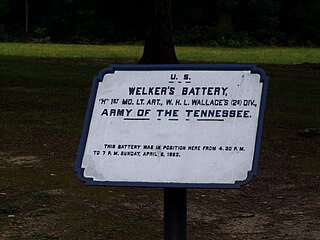12th Indiana Battery Light Artillery was an artillery battery that served in the Union Army during the American Civil War.
17th Ohio Battery was an artillery battery that served in the Union Army during the American Civil War.
1st Maine Light Artillery Battery was an artillery battery that served in the Union Army during the American Civil War.
Battery A, 1st Missouri Light Artillery Regiment was an artillery battery that served in the Union Army during the American Civil War.
Battery "A", 2nd Regiment Illinois Volunteer Light Artillery, was an artillery battery that served in the Union Army during the American Civil War. The battery was alternately known as Davidson's Battery, Borris' Battery, and Peoria Light Artillery.
Chicago Mercantile Independent Battery Light Artillery was an artillery battery that served in the Union Army during the American Civil War.
The 1st Indiana Light Artillery Battery was an artillery battery from Indiana that served in the Union Army between August 5, 1861, and August 22, 1865, during the American Civil War.
14th Indiana Battery Light Artillery was an artillery battery that served in the Union Army during the American Civil War.
16th Indiana Battery Light Artillery was an artillery battery that served in the Union Army during the American Civil War.

1st Regiment Indiana Heavy Artillery was a heavy artillery regiment that served in the Union Army during the American Civil War. It was nicknamed the "Jackass Regiment". Before being converted into an artillery unit in 1863, it served as the 21st Regiment, Indiana Volunteer Infantry.

1st Connecticut Heavy Artillery Regiment was an artillery regiment that served in the Union Army during the American Civil War.
The 75th New York Infantry Regiment was an infantry and cavalry regiment in the Union Army during the American Civil War.

The 1st Connecticut Light Artillery Battery, recruited from the state of Connecticut, served in the Union Army between October 26, 1861 and June 11, 1865 during the American Civil War.
Battery D, 1st Missouri Light Artillery Regiment was an artillery battery that served in the Union Army during the American Civil War. Organized before February 1862, Battery D fought at Fort Henry, Fort Donelson, Shiloh, Corinth siege, Corinth, and Missionary Ridge. After serving in the Knoxville campaign, the battery garrisoned Huntsville, Alabama until April 1865. At that time it was consolidated with Battery C, 1st Missouri Light Artillery Regiment which was mustered out in July 1865.

Cogswell's Battery Illinois Light Artillery was an artillery battery from Illinois that served in the Union Army during the American Civil War. Organized in November 1861 as Company A, 53rd Illinois Infantry Regiment, it was detached as an independent artillery battery in March 1862. The battery participated in the Siege of Corinth in May 1862. The unit remained near Memphis, Tennessee until June 1863 when it was ordered to reinforce the Siege of Vicksburg. Cogswell's Battery took part in the Jackson Expedition, the Missionary Ridge and in the Knoxville campaign in 1863. After performing garrison duty for most of 1864, the unit fought at Nashville in December. In spring 1865, the battery fought at Spanish Fort and Fort Blakeley during operations against Mobile, Alabama. The battery was mustered out in August 1865.

Battery F, 1st Missouri Light Artillery Regiment was an artillery battery unit from Missouri that served in the Union Army during the American Civil War. The battery participated in operations in December 1861. Battery F fought at the battles of Prairie Grove and Van Buren in December 1862. The battery fought at Vicksburg, Brownsville, Mustang Island, and Fort Esperanza in 1863. The unit fought at Spanish Fort, and Fort Blakely in 1865. Battery F was mustered out on 11 August 1865.

Battery H, 1st Missouri Light Artillery Regiment was an artillery battery unit from Missouri that served in the Union Army during the American Civil War. The 1st Missouri Light Artillery Regiment was created on 1 September 1861. Battery H fought at Fort Henry, Fort Donelson, Shiloh, 1st Corinth, and 2nd Corinth in 1862. The battery performed mostly garrison duty in 1863. The unit was in action in the Atlanta campaign and Sherman's March to the Sea in 1864 and in the Carolinas campaign in 1865. Battery H marched in the Grand Review of the Armies before being mustered out on 16 June 1865.

The 15th Massachusetts Battery was an artillery battery that served in the Union Army during the American Civil War. The unit was organized partly at Camp Chase in Lowell, Massachusetts and partly at Fort Warren during the winter of 1862-1863. The majority of its members were mustered into federal service on February 17, 1863. It was assigned to the Department of the Gulf commanded by Major General Nathaniel P. Banks and departed Massachusetts by steamship on March 9. During its term, the unit suffered from a large number of desertions and gained an unfortunate reputation despite the service of its many loyal members.

1st Missouri Light Artillery Regiment was a artillery unit from Missouri that served in the Union Army during the American Civil War. The unit began its service as the 1st Missouri Infantry Regiment, but converted to an artillery regiment in September 1861 and was brought up to a strength of 12 companies. Thereafter, each company served as an individual artillery battery, often separated from the other companies in the regiment. The individual batteries served in many actions in the Western Theater of the American Civil War and several batteries served together at key battles such as Fort Donelson, Shiloh, Corinth, Prairie Grove, and Vicksburg.

Battery "G", 2nd Illinois Light Artillery Regiment was an artillery battery from Illinois that served in the Union Army during the American Civil War. The battery was organized at the end of December 1861. It fought at Vicksburg in 1863, Tupelo and Nashville in 1864, and Spanish Fort and Fort Blakely in 1865. The battery was mustered out in September 1865.








